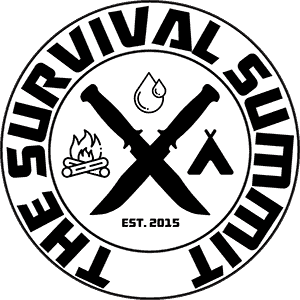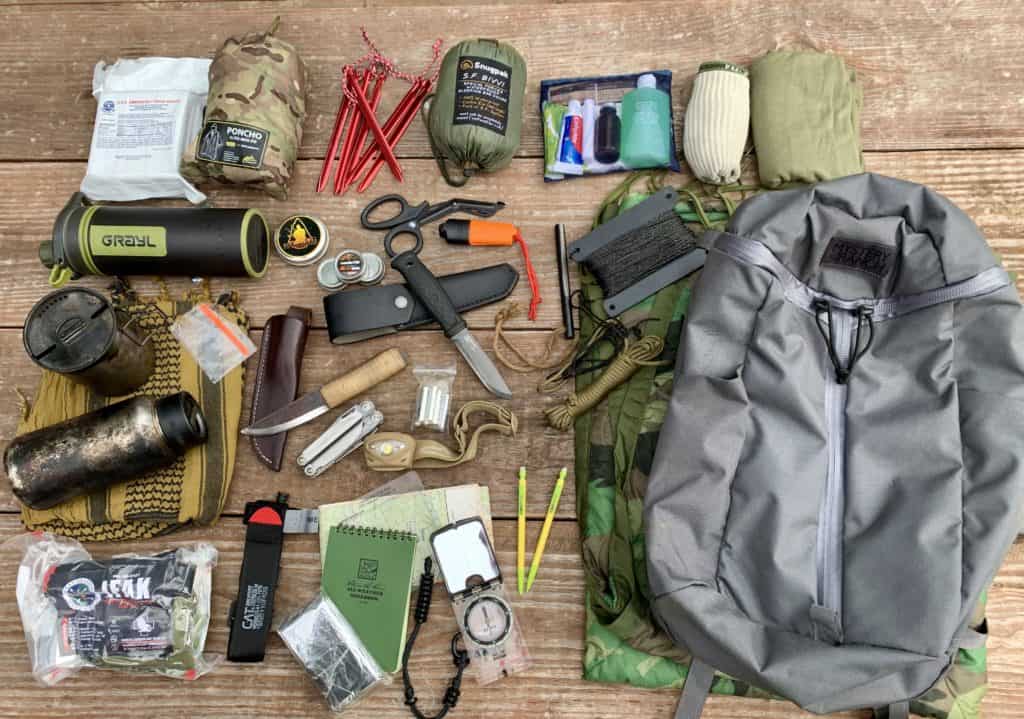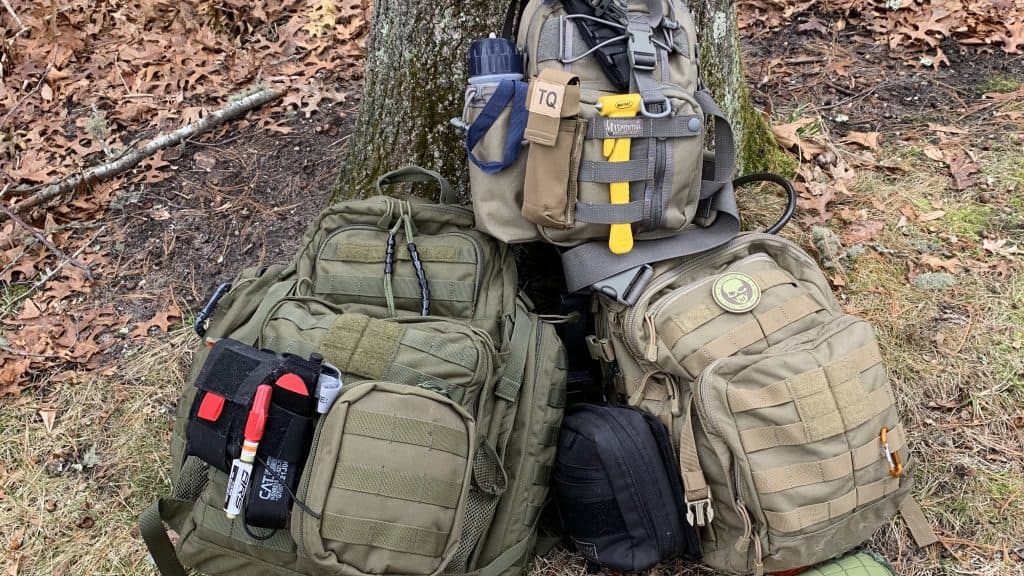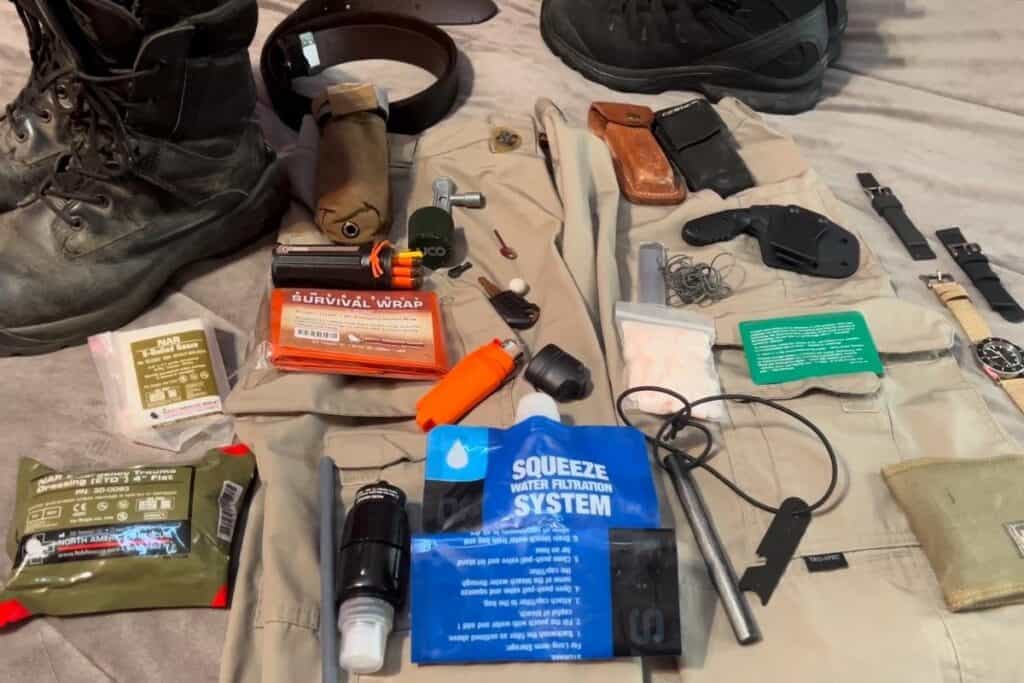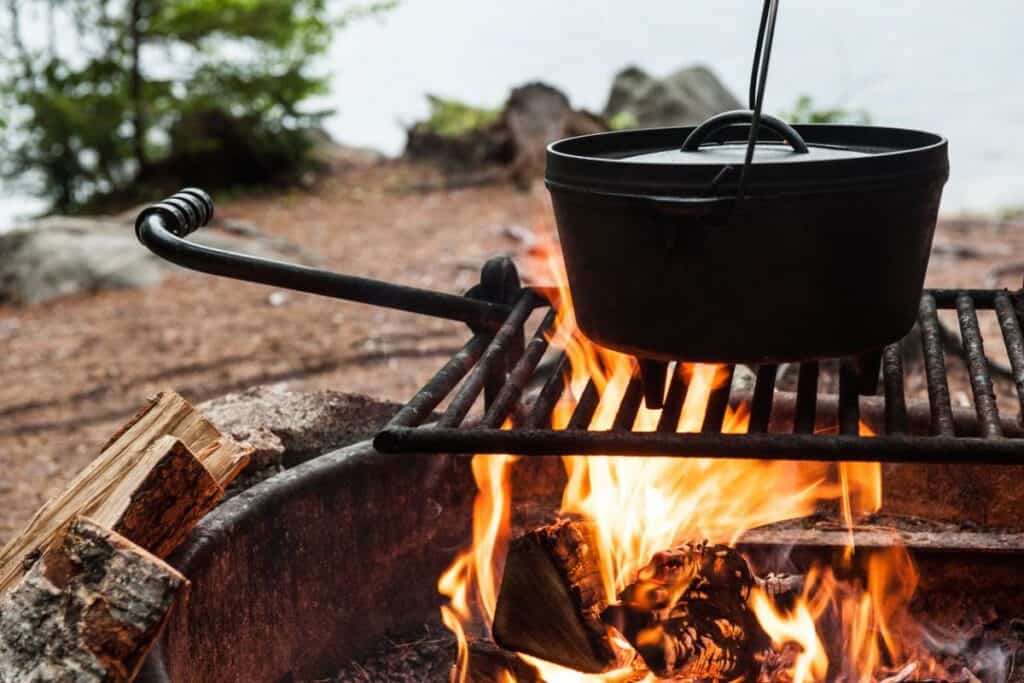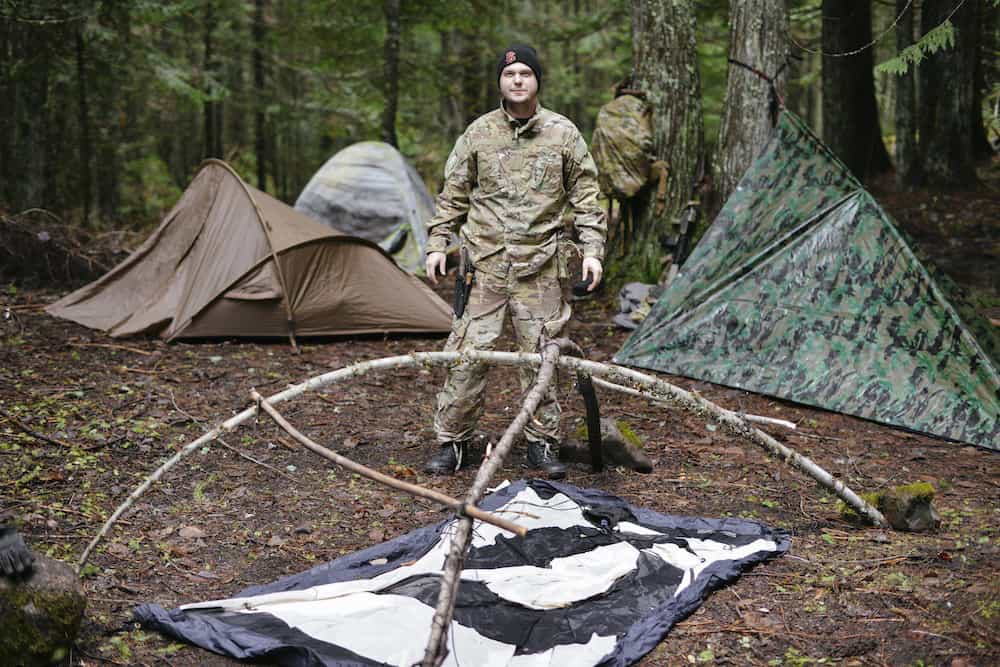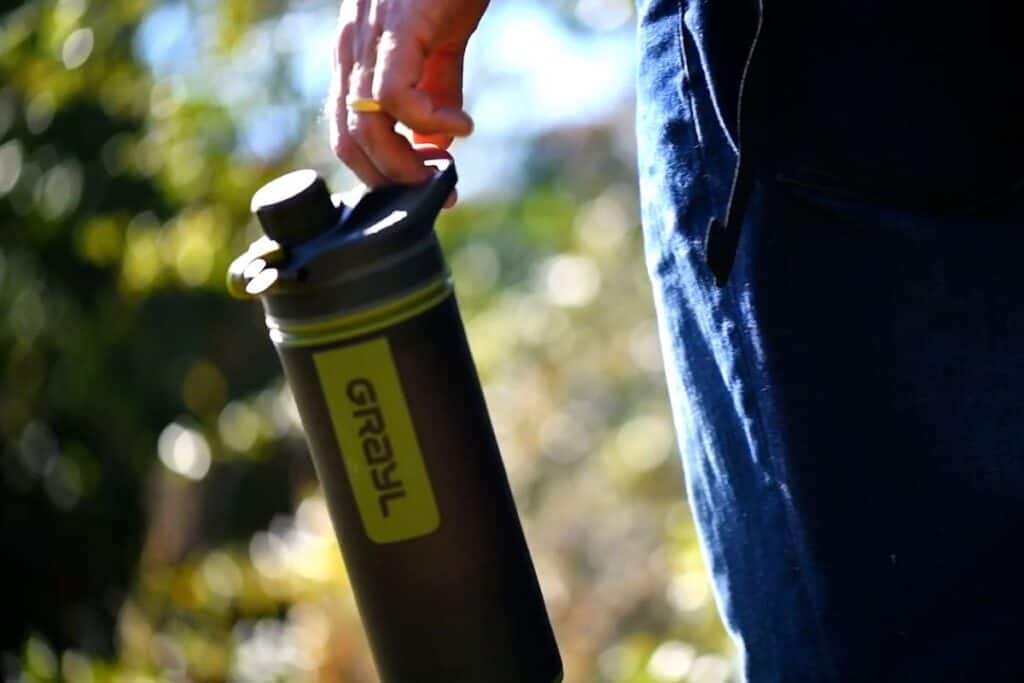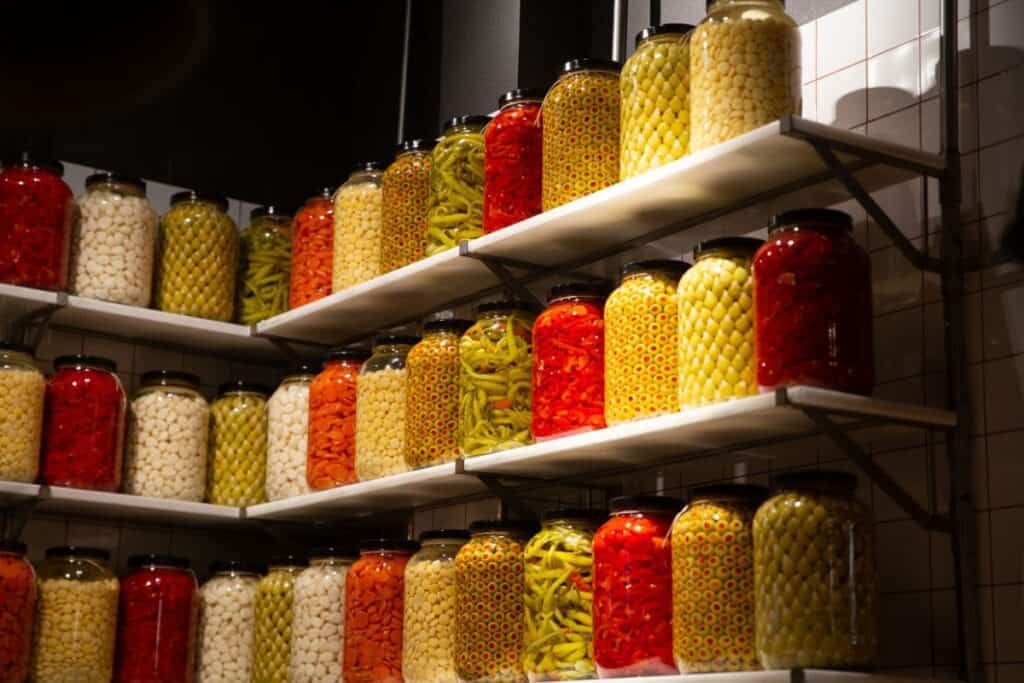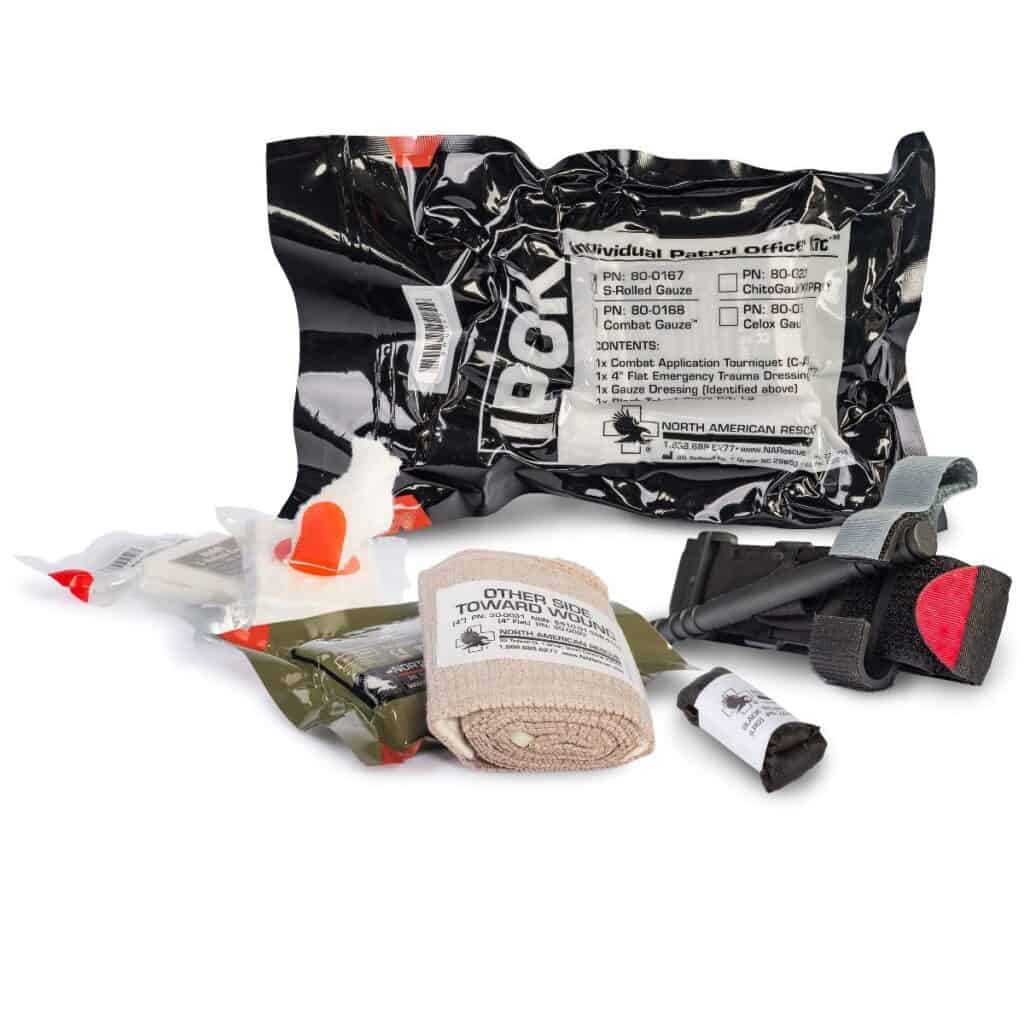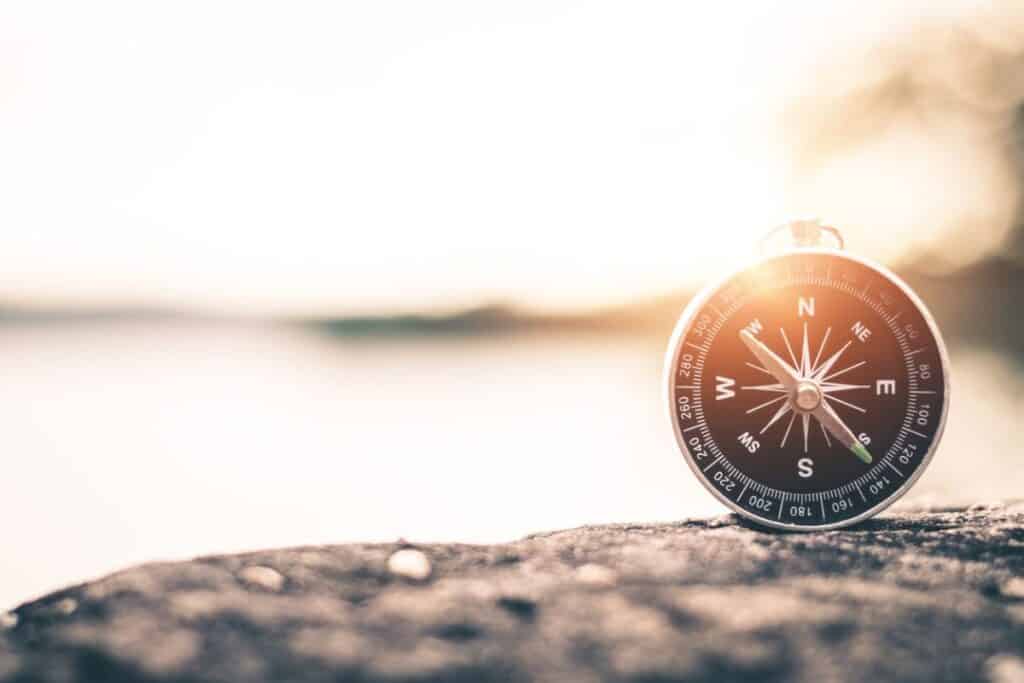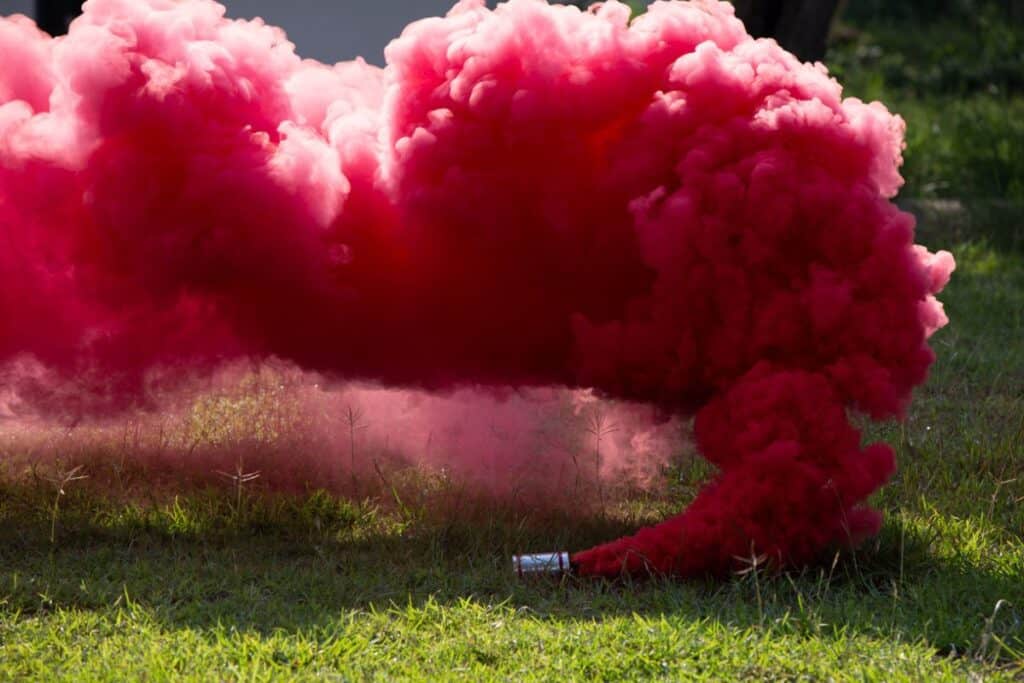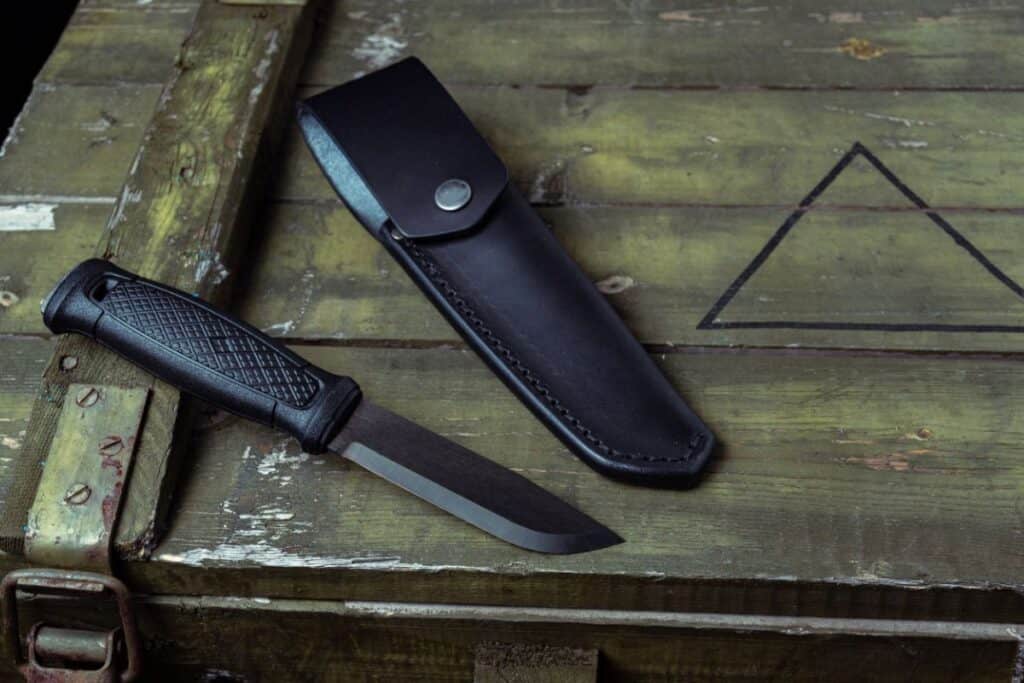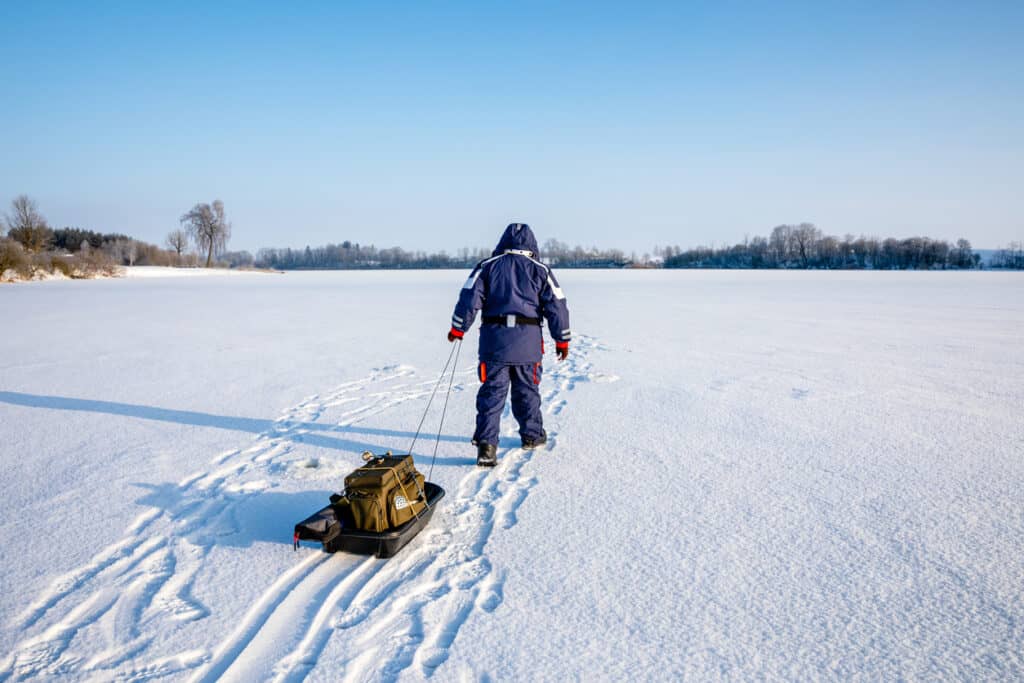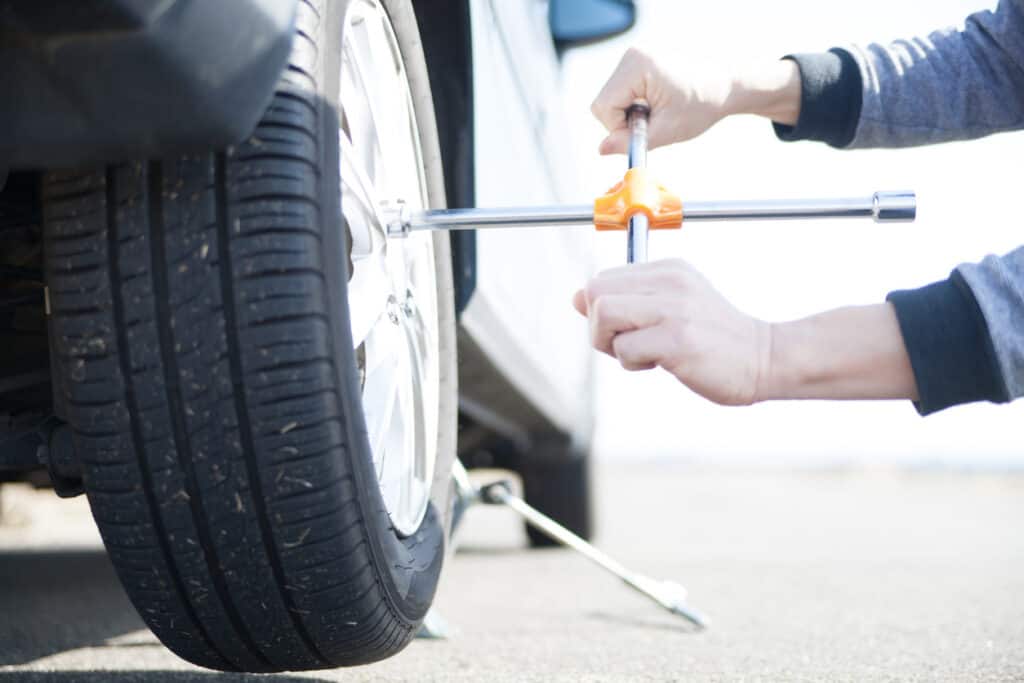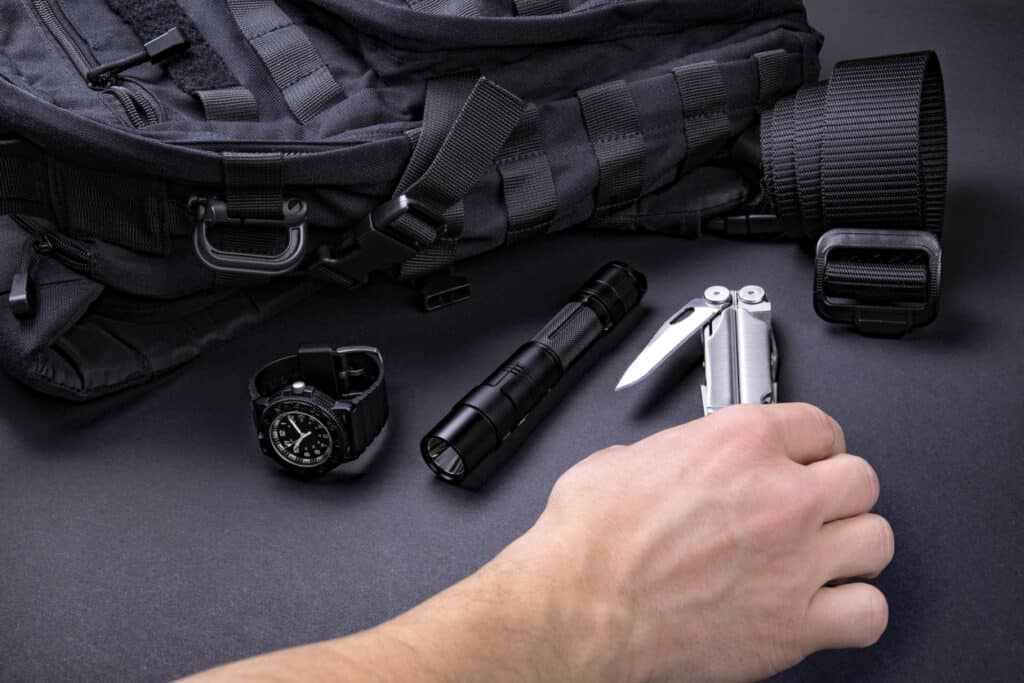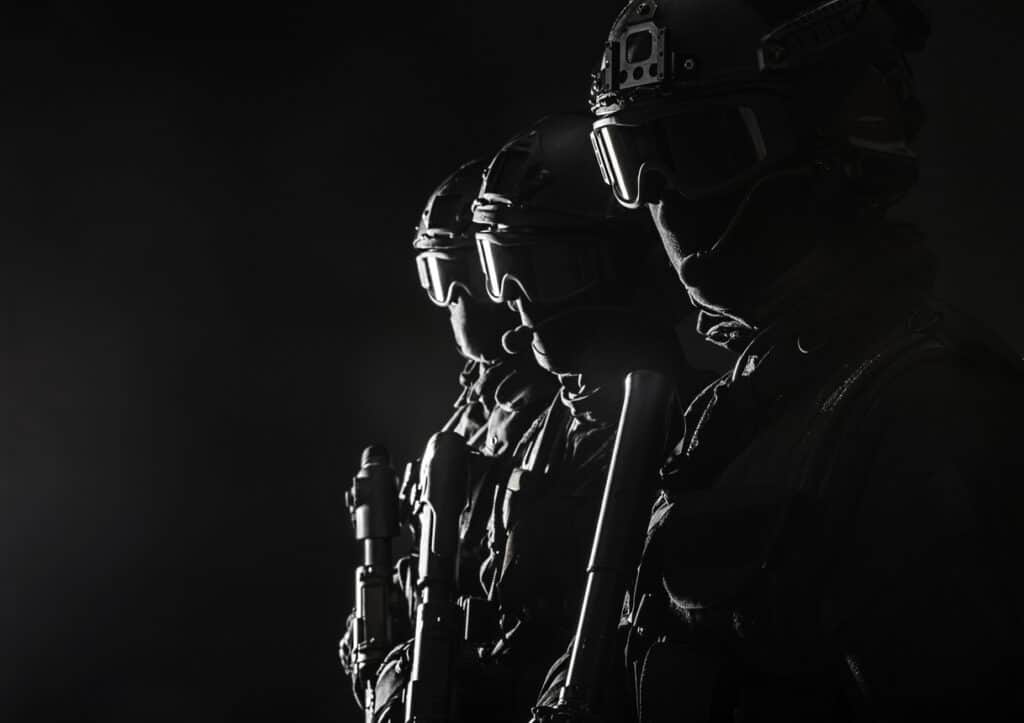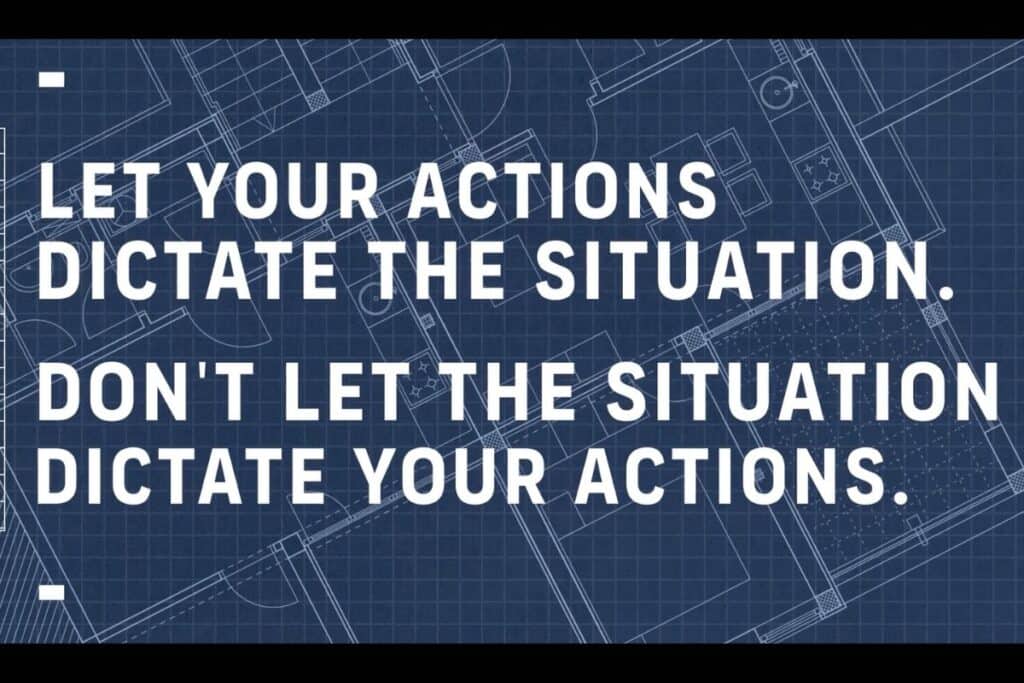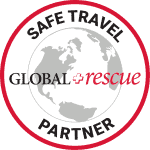Survival Gear the Unanswered Questions
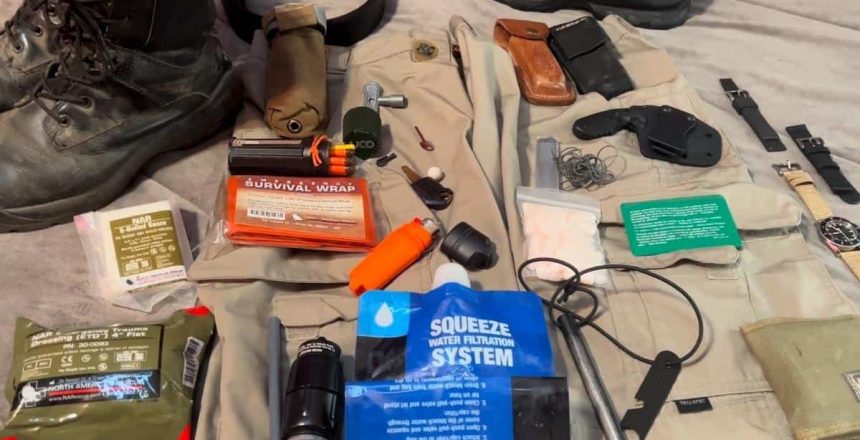
Survival Gear the Unanswered Questions
[ez-toc]
Introduction
You often hear the term, “Survival Gear,” but what does that mean, and why do you care? Survival gear is the gear we need to cover our core needs as humans. The rule of three is something we encourage you to remember in terms of survival. The rule of three is simple; You can survive approximately three minutes without air, three hours without shelter in extreme cold or heat, and three weeks without food.
The rule of three uses baseline numbers, so be careful. Those timelines can change drastically based on weather conditions, physical activity, air quality, and how many overall calories you are burning in a survival situation.
Here are some examples; If you are breathing in smoke or chemicals, you can die much more quickly. If you are in sub-zero temperatures, hypothermia can take you out very quickly, and in extreme heat, hyperthermia is just as dangerous.
Can you survive three days without water? In certain conditions, yes, but if you are on the move and sweating, especially if it is extremely hot out, you could die in a matter of hours. You can lose between 1 and 1.5 liters of sweat per hour, according to Randall Parker, a biologist at George Washington University.
Dehydration is extremely dangerous and should be taken very seriously if you exhibit any symptoms, such as extreme thirst, less frequent urination, no urination at all, no tears if you are crying, as well as dizziness and confusion.
How long can you survive without food? You will often hear survivalists on social media or YouTube talk about not carrying any food in their bugout bags, or during a long hike, because they believe they can survive for nearly a month without eating. We can assure you, as can expert survivalists, that it is not quite that simple. Do not be fooled into thinking you do not need to take in calories when out in the wilderness.
Human starvation has many factors, such as your age, weight, body fat content, fitness levels, general health, and most importantly; your activity level when you are out there building a shelter, hiking to search for water, and any other activities where you are expending calories. You will also become very weak if you are not eating and expending a large number of calories.
When you are starving, you will become nauseous, weak, and feel unwell, which may prohibit your ability to function normally. Dehydration can also play a significant role in how dangerous starvation can become.
Survival gear comes in many shapes and sizes, and many price ranges, and there are countless products on the market, but it is especially important to make sure you are buying high-quality, field-tested gear as often as possible. The last thing you want to experience while you are in an actual survival situation is gear failure.
If you do not possess an exceedingly elevated level of primitive skills, you will be more gear reliant, so the quality of your gear is literally going to be the difference between life and death.
In this article we are going to discuss why having a survival gear kit is so important, what some of the best-field-tested gear is based on experts who have spent decades in the field, what you would typically pay for a baseline survival kit, an entry-level kit, and a top-of-the-line kit to provide all of the essential survival gear. We will also discuss the difference between “tactical” gear and “Survival Gear,” the “must have’s” for every kit, EDC (everyday carry), and the top three items for any loadout.
Before we get started, let’s discuss all of the articles, blogs, and videos out there discussing various types of “bugout” bags. There is EDC (everyday carry). There is the “get home” bag, the “bugout bag”, and the INCH bag (I’m never coming home). Outside of EDC gear, We personally do not subscribe to having all these other types of bags put together.
You never know where you may be, what may happen, how far you might need to travel to get home, or how long that might take. If I’m only carrying a smaller “get home” bag on my way to work, and something crazy happens, all of my needs may not be taken care of in that bag.
We believe that since all of your core needs are the same, aside from supplemental gear for the different seasons and climates, one bag is enough to cover all of those needs. You can put together an 18-25 lbs. bag that covers your needs pretty easily. If you’re implementing a solid P.A.C.E. plan (Primary, Alternate, Contingency, Emergency), that also includes caches along frequently traveled routes, you should be able to travel pretty fast and light wherever you are going.
There is also a lot of planning that will be specific to you and your family’s needs, so aside from the basics, not everyone’s survival gear kit will be the same, so don’t get caught up in “experts” saying that they are right and others are wrong. That’s just hubris at its finest.
1. What is Survival Gear?
Survival Gear is the gear required to provide for your needs in any survival situation and can prevent you from getting into a survival situation in the first place. When we talk about Survival Gear, we are not just talking about gear to procure safe drinking water, a shelter system to keep you out of the elements, gear to help you start a fire, emergency food rations, or methods of food procurement; you also have to think about first aid gear for small injuries such as cuts, scrapes, and blisters, to trauma gear to stop bleeding, such as tourniquets, or splints for mobility if you have a mechanical injury.
You should also have a good signaling kit to assist in getting yourself rescued, such as a signal mirror, a loud whistle, chem lights, orange or another brightly colored smoke cartridge, chalk for leaving messages on rocks or trees, reflective patches or gear, and a bright orange signal flag or mylar blanket that has orange on one side and a reflective reverse side.
Fire starting gear is also particularly important so that you can create smoke signals to attract attention; not only visually, but from people smelling smoke from longer distances.
It may not always be someone seeing smoke that calls for help, it may be someone who smells it, so do not be discouraged if it is a very windy day and you do not think smoke signals are working. Someone may alert forest rangers to a potential forest fire if they smell smoke strongly enough.
Navigation is also critical. Having a proper navigation kit can keep you from even getting into a survival situation in the first place. Having, and knowing how to use a compass, is especially important. You should also have a map of the area you are going to be in if you have pre-planned hiking, hunting, or camping trip.
Some people think that just carrying their cell phone will be all they need for navigation, but if you lose your signal, what are you going to do then? We recommend carrying a battery-powered GPS unit as your main navigation tool, along with a small portable solar charger, but you STILL need to carry a compass, and a TOPO map of the area if you are able to.
What about knives and tools? A high-quality knife will be your best friend in any survival situation, so be sure that you are not going cheap when it comes to knives and tools. The more survival skills you learn, the less reliant you will become in terms of survival, and a knife is one of the key items you should always carry with you.
With enough training, you can learn to survive with nothing BUT a knife but let us not get ahead of ourselves. Crawl, Walk, run applies in this situation, especially since most of us are not EJ “Skullcrusher” Snyder.
2. Why is a Survival Gear Kit Important?
So far, we have discussed “Survival,” and the core Survival Gear that you should be thinking about having, and we have touched upon why this gear is so incredibly important, but the importance of a quality Survival Gear kit cannot be overstated, and having an accessible kit for emergencies is critical.
Owning a survival gear kit, but keeping it in your basement at home does not do you any good. We like to keep a quality EDC (Everyday Carry) kit on our person, as well as keeping a kit in our vehicles, and one at home. If you live in an area where it gets freezing cold and snows a lot, do you keep a shovel in your car? Do you have excellent quality winter boots, a hat, and gloves in your vehicle wherever you go? Often times the answer to the question of whether or not people keep winter supplemental gear in their vehicles is No, and that is a problem.
More often than not the reason people do not carry gear in their vehicle is that they believe that the safety of their warm vehicles will always protect them and that if they should break down, they can easily call for help. That, unfortunately, is not always the case. Another overlooked fact is that a lot of people have no idea how long they have the ability to walk in perfect conditions, never mind extreme conditions, so if you become stranded and have to make it out on foot, are you prepared for that? Will you make it? Do you have a medical condition that prohibits you from physical exertion?
Do you remember the story about the couple and their baby that were found on a hiking trail in California? These kinds of incidents happen much more often than you think. The family died from hyperthermia and dehydration, only a couple of miles from their vehicle. It was a very tragic accident that is a reminder to us all that not being prepared can cost you your life.
We were watching the news around the time when Ukraine had just been invaded by Russia, and people by the hundreds of thousands were fleeing their homes and making their way to the border, and all I could think of was the fact that there were so many of them who most likely did not have a survival gear kit at all, never mind a good quality kit, and a lot of them were traveling many miles on foot to escape the war.
You may be saying, “yeah, but there isn’t going to be a war here in the United States,” and maybe you’re right, but do you remember hurricane Katrina? A lot of people died after that storm, and a lot of people did not have access to water, medical attention, or food for an entire week. You cannot rely on the government to help you in every situation. You must be self-sufficient enough to care for your own needs for as long as possible, as well as the needs of your entire family.
We think that at this point, most people understand the need for a quality survival gear kit, and for those of you who are brand new to survival, we hope that this article gives you some things to seriously consider. No one is saying that you should instantly become a “doomsday prepper,” but at the very least you should have the right gear that covers your basic needs as a human being.
There is nothing extreme about being prepared, and do not let people tell you that you are succumbing to “fear-mongering.” Most times the people who say nonsense will be the ones who do not make it in a survival situation, and they are walking around as if nothing could ever possibly happen to them. The old saying goes, “It’s better to be a warrior in a garden than a gardener in a war.” That holds true even now in 2022.
3. What is the best Survival Gear?
Before we dive into what we believe is the best survival gear on the market, let me just say that there are plenty of brands that have very high-quality gear, and just because we may not have mentioned one particular piece of gear, does not mean it’s not ranked up there at the same level as some of the gear we mention.
To make this simpler, we are going to lay out our recommendations by category (not in any particular order:
Fire
BIC Lighter – Having a decent quality lighter is very important for starting a fire quickly, but of course, it should not be your only source of fire-making tools rather it could be the “primary” tool in your overall gear P.A.C.E. Plan, and your alternate, contingency, and emergency tools should also be available. Even if you think you are EJ Snyder or Les Stroud, don’t box yourself in by only carrying minimal gear no matter what.
If you have the ability to carry gear that goes far beyond bushcraft or primitive skills, you should be carrying it. If you had the choice, you wouldn’t bring a knife to a gunfight just because you’re good with a knife, would you? If you answered yes to that question, you should probably just stop reading because we can’t help you. 😉
Next on our list would be a good solid Ferrocerium rod or “Ferro” rod. We absolutely love the Uberleben Kraftig ferro rods. They throw amazing sparks and are very long-lasting. You can probably get 10,000 strikes from one of their 5” rods. We recently came across a brand called Kupilka that makes a smaller fire steel that is a great choice for fire-starting.
Another great item that is the size of a credit card and insanely light is a Fresnel lens. A Fresnel lens is a type of composite lens that acts as a magnifying glass. It can also be used for signaling, and anything that is dual purpose is also a plus (within reason, don’t go buying a “Rambo” survival knife from Amazon).
We personally never go anywhere without a UCO Titan Stormproof match set. These matches burn so well that you can light them and hold them underwater, and they will still keep burning while under the water. They are, in our opinion, the best stormproof matches on the market today.
We could get into the weeds as far as beeswax candles, Fatwood shavings, and other tinder types, but those are not fire-starters, even though they are used to get a fire started much easier, and are especially useful if your natural tinder, such as leaves, grass, and bark, are on the wet side.
But since we mentioned it, our favorites are; TSS Fatwood shavings, Exotac CandleTin candles, Uberleben “Tindar” wick and bellow, TSS Fire Tabs, and of course, char cloth in an Altoids type tin so we can use the tin after it’s all gone to make more char cloth, or for punk wood.
Shelter
For Shelter, we always like to keep either a Helikon or MIL-TEC rain poncho because these two brands are the only two ponchos we’ve ever found on the market, aside from surplus military ponchos, where two of them can be snapped together to make a tarp shelter. These ponchos are another great example of dual-purpose items that we believe everyone should have on hand.
Next up is the Poncho liner, or what some people call the “Woobie”. The woobie is a poncho liner and can also be used as a decent blanket or layered into a sleep system. Some people love to wrap up in their Woobies and then crawl inside of a Snugpak Special Forces Bivvi.
Snugpak makes an amazing sleep system of sleeping bags and a bivvy that can be used in any climate. The Snugpak special forces complete sleep system is pretty expensive but worth its weight in gold if you’re in a colder climate. They are also very compact and light. MIL-TEC also makes a pretty nice sleeping bag.
You can never go wrong with a good old-fashioned Wool Blanket. Wool will maintain an amazing amount of its warmth even when it’s wet, which is why we believe it is a superior fabric. You should always keep a “space blanket” in your kit as well.
The North American Rescue emergency survival wrap is a much higher quality piece of equipment than some of the cheap versions you’ll find in a big box store. The reflective side reflects up to 90% of radiant body heat and is made with tear-resistant polyethylene fabric. The opposite side is bright orange, so you have another method for signaling as well.
Another great item to have, if you can spare the extra weight and have the room, is a Tentsmiths Oilskin or flame-resistant canvas tarp. They weigh around 5-9 lbs. though, depending on the size you order, so they can be cumbersome to keep with you.
Another great canvas product is called the “Bed Sleeve,” originally designed by the maker of the “Jon Pack Bed Sleeve”. It can be used as a “browse bed”, meaning you can stuff it with leaves or debris to make a bushcraft mattress to sleep on, or you can suspend it on two logs and use it as a cot.
Two other important shelter items are 550 paracord and twisted and tarred #36 Bankline. These are essential if you are creating shelters using your ponchos or a tarp. These cordage items have so many great uses in the survival world, so you should always try to have some in your survival gear.
Some people also like to utilize an excellent quality tent, and Snugpak makes some very high-quality tents if you’re not looking to rig up a tarp shelter system or build a primitive shelter. Tents are too bulky for us, so we don’t like to carry them with us unless they are part of a supplemental winter kit that can be pulled in something like an ice fishing sled.
Water
When it comes to water procurement and filtration, we are huge fans of single-wall stainless steel water containers, such as the Pathfinder Bottle and Cup Set. The Pathfinder set comes with a bottle to boil your water in, as well as a cup to do the same, and the bottle sits inside of the cup, so you have two containers in one.
Having a stainless steel or titanium bottle set is especially important when you are in an area with snow and ice and limited or no access to running water that hasn’t frozen over. You can easily melt ice to boil. You do not want to boil snow as that will be a waste of time.
The snow to water ratio is about 10-1, meaning for every 10 inches of snow, you’ll get 1” of water. Boiling your water in the sub-zero temps is also going to keep any of your membrane water filters from freezing and cracking and becoming unusable.
Our favorite two filters on the market that we consider “Must have Survival Gear”:
The Grayl Geopress and the Sawyer Micro Squeeze. Before we get into these two filters, note that it’s always important to pre-filter your water to help keep the elements clean of debris, which can prolong the life of your filters. We love using either a Shemagh or a canvas pre-filter bag. A shemagh is normally made of cotton while the pre-filter bags are made with heavy-duty canvas, and they both do an excellent job of pre-filtering your water.
First up, is our personal favorite; the Grayl Geopress Purifier. The Grayl Protects from global waterborne pathogens (virus, bacteria, protozoan cysts), pesticides, chemicals, heavy metals, and even microplastics. It utilizes a triple-charged mesh that traps germs and bacteria and an activated natural carbon filter.
The Grayl Geopress also has a special integrated anti-microbial agent that suppresses the growth of mold, mildew, and bacteria. This filter is super easy to use. You simply slide the inner portion of the filter out of the housing, fill the housing with water, and then push the inner piece through the housing, so the water is pushed through the filter.
It only takes about eight seconds to have drinkable, and great-tasting water. Also, we just recently saw on social media that Pathfinder has designed a new stainless-steel cup that the Grayl Geopress will perfect sit inside. Stay tuned for that!
The Sawyer Mini, or the Sawyer Micro Squeeze – These filters both removes 99.99999% of all bacteria, such as salmonella, leptospirosis, cholera, and E.coli, removes 99.9999% of all protozoa (such as giardia and cryptosporidium), and also remove 100% of microplastics, but it is very important to note that they DO NOT remove Viruses, so if you’re in a part of the world where viruses in the water are common, BOIL your water!!
The Sawyer Micro Squeeze is our favorite. It is super compact and lightweight, and we actually store one inside of our Grayl Geopress to save space. They have a lifetime warranty, and if kept clean, pre-filtered, and backflushed, can last up to 100,000 gallons, which essentially is a lifetime for most people.
The Sawyer Micro Squeeze filter allows you to drink directly from the water source, put inline of a Camelbak water bladder, be attached to a bottle, and even come with a water pouch. Speaking of a water bladder, we personally would never use anything other than the Camelbak brand, based on field use.
Food
Here we are talking about food, the subject of much debate about whether you really need food in your Survival Gear kit. The answer is YES, you do want to carry some form of rations. If you have to move miles on foot, why would you not want to be in optimal condition while doing so?
If you attempt to get home after an incident or natural disaster happened, and you get stranded for a few days, trust us when we say you’re going to want to be able to replace your expended calories. It may take you a lot longer to get home if you’re weak from being hungry.
One of our favorites is the SOS emergency rations. They don’t taste too bad, and we prefer the 3600-calorie bars that have a 5-year shelf life. These rations can withstand temperature ranges of -22°F to +149°F, so you do not need to worry about your food spoiling in extreme heat or freezing during the winter.
If you learn how to make Pemmican, that is an excellent food source to keep in your survival kit or bugout bag. It also would not hurt to learn as much as you can about wild edibles and foraging. There is plenty to eat out there in the wilderness than you might think. There are plenty of other types of emergency rations, so do your research and buy what works best for you and be sure to taste test a bunch of assorted brands as well.
First aid
There is a big difference between a “boo-boo” kit and first aid or trauma kit. A lot of kits on the market are simply band-aids and terrible quality gauze. If you’re looking for a solid first aid kit, North American Rescue has some incredible kits. Just a few years ago you could hardly find a kit that encompassed basic first aid as well as trauma gear, but that is no longer the case.
NAR has a few outdoor kits that cover bandages, compressed gauze, pressure dressings, tourniquets, moleskins, butterfly bandages, alcohol prep pads, antibiotic ointment, and triangular bandages (for slings), hypothermia wraps, and much more, all in a pretty compact kit.
You can also get kits that have decompression needles and chest seals for sucking chest wounds, but you should have training in TCCC, TECC, or another equivalent course if you’re going to carry that type of gear. Having a good splint in your kit is another necessity for those mechanical injuries, such as sprained or broken ankles, legs, and arms.
The bottom line is that you should have a solid first aid setup with every survival kit you own, and you should know how to use it. Just don’t carry so much gear that it takes up half of your kit. It’s fine if you want to carry a large trauma kit in your vehicle, but don’t make it part of your fast and light bugout bag.
Navigation
For Navigation, we love the Suunto 1:25 scale global compass, a protractor, and a TOPO map of the areas we frequent. If you’re in a city, keep a city map that covers not just your city but surrounding cities as well. Also, keep a waterproof notebook and pencil so you can take notes and write down important navigational information. Pace beads can also come in handy to keep track of distances.
We also carry a compass, but we prefer our primary to be a handheld GPS, such as a Garmin GPSMAP 64st. Garmin, as well as other good brands, have a lot of different models, but we prefer this particular model. We also carry a small solar charger in our kit to recharge any electronics we carry, such as a Satellite phone.
Garmin also makes some nice navigation watches, as does G-Shock, such as the G-Shock Rangeman, which has a compass, an altimeter, and a barometer. Technology has come a long way over the years, so don’t be shy about using technology as your primary, but ONLY IF you learn how to use a compass and a map FIRST! You can’t always rely on technology, so don’t use it as your sole navigation source.
Signaling
Regarding what we recommend for signaling, you should always have a good flashlight, such as a Nitecore, Fenix, Streamlight, or a Surefire. Newer flashlights have incredibly powerful batteries that can be recharged via a small solar charger, so don’t think you need to use AA or AAA battery flashlights anymore. If you use a solar charger, go with at least a 20,000 MAH version.
We do not have a preference for a signal mirror and whistle if they are good quality and made by a reputable brand name. Do not buy cheap Chinese gear, EVER.
We are a huge fan of satellite phone technology, and today’s monthly pricing for around 60-100 minutes a month is comparable to cell phone plans. Why not have an emergency device when you have zero cell phone signal? You can even sign up for search and rescue insurance for only $30/month.
Most people go for Iridium Sat. phones, but it is much more expensive and unnecessary for most people as the Inmarsat phone coverage is nearly the entire world except for the extreme north and south poles.
Knives and Tools
Without trouble, our favorite knife is the Mora Garberg Carbon black with the leather sheath. It is a full-tang knife with an excellent 90-degree spine for throwing an insane amount of sparks off of a Ferro rod. In our opinion, it is one of the best survival knives. More great knives are the EJ Snyder SXB by TOPS knives and the Mountain Predator by Stroup knives. These two knives can be used for small jobs and can also be used as choppers.
For camping and survival gear, before you go freaking out and list off a ton of other brands, the knives we mentioned are just some of our favorites. There are literally hundreds, if not thousands of amazing blades out there on the market, and as long as you understand which steel and blade types are best for what you need them for, the list of knives to choose from is incredible.
Next up is the Silky Saw. Silky makes the best saw on the market, such as the new Outback Gomboy and the Pocketboy. These saws make quick work of lumber and will save you a lot of calories when building a shelter in the forest. The new outback models can even cut through animal bones fairly easily. Whatever you do, just please do not buy the cheap wire hand saws. Those will not hold up in the field.
If you feel like carrying extra weight, or you want one in your supplemental kit, we’d highly recommend a hatchet or an ax. We LOVE the Hults Bruk axes that are made in Sweden. They are simply amazing.
You may also want to consider carrying a gear repair kit with a sewing needle in case your backpack or other gear needs to be repaired in the field.
Backpack or Pack
There are so many backpacks on the market, but we have fallen in love with the 5.11 Covrt18 backpack. It is a “gray man” style pack that has a ton of great features and pockets. If it’s wintertime, we sometimes go with the 5.11 Rush 72 2.0, which holds a lot more gear, such as a wool blanket, a Woobie, and a Bivvy, as well as the rest of our gear.
We also love the 5.11 Rush series packs because you can attach supplemental kits outside the pack. It does have molle, so if you are concerned with the “tactical” look, that pack is not for you. Mystery Ranch also makes some pretty amazing backpacks.
Supplemental Items
Basic Winter items
- Ice fishing sled to carry gear
- Queen-sized wool blanket
- High-Quality Winter boots and Wool Socks
- Wool Hat and/or balaclava
- Insulated gloves or mittens
- Polypropylene bottoms and top
- Quality Winter jacket and pants
- Folding Shovel
- Sleeping bag rated for negative temps
- Snowshoes
Some basic tools to keep in your vehicle would include
- A roadside assistant kit that includes flairs and jumper cables
- Empty gas can and gas siphon
- Fire extinguisher
- Shovel (the shovel becomes especially important during the wintertime)
- Basic tool set (sockets, wrenches, crowbar, pliers, etc.)
- Tire inflator and/or fix-a-flat
- Road maps
- Glass break and seatbelt cutter (should be a tool on your person)
- Solar-powered survival gear, such as power banks.
EDC Items
When it comes to EDC, of course, you will want the firearm that you normally carry, along with a holster and extra magazines. You will also want a good knife to keep on your belt, a multi-tool and a tourniquet. A tourniquet, such as the Gen. 7 CAT TQ by North American Rescue that you carry on your belt, should be your primary tourniquet, and your secondary should be in your IFAK (individual first aid kit).
We also like to layer escape and evasion gear on our people, such as a lockpick set, various handcuff keys and shims, Kevlar cordage, and glass break tools. We also like to replace our shoe and/or boot laces with paracord or Kevlar so that, if need be, we can escape from rope, heavy-duty zip ties, and duct tape with relative ease.
Again, we highly recommend training on any and all gear you carry or plan to use, especially firearms. Wazoo Survival Gear makes some great items, such as the “cache cap” or the “cache belt”, which are both pretty amazing items for EDC.
I personally keep a lot more EDC gear on me as backups to my bugout bag, and I wear cargo pants with a ton of pockets in the case, for whatever reason, I get separated from my bugout bag. I won’t get into exactly what I carry as EDC, but I did make a TikTok video that showcased my entire kit. You can watch that HERE.
4. How much should a Survival Gear kit cost?
When it comes to the cost of survival gear, there is the top-of-line gear that you are going to pay a little bit more for, and then there is some gear that isn’t quite as good but will still serve you well in a survival situation. A good bugout bag that covers all of your essential needs could cost you anywhere from $1,000 to $1500+, and less expensive supplemental kits, such as the B.O.S.S. kits made by Stafford Outdoor Supply, would cost you around $300-$500, including a medical kit, fire, shelter, water, signaling, navigation, and a fishing and hunting kit.
We prefer to carry top-of-the-line, field-tested gear in our packs and use the B.O.S.S. kits as supplemental gear that we can keep in our pre-staged caches along the routes to different locations in our overall P.A.C.E. plan. Just remember that you get what you pay for, and you need to test and train with your gear as often as possible, which the exception of your medical gear, of course. If you are going to train with medical gear, do not use the gear that is in your bugout bag or part of your EDC Kit. Pick up some training gear and use that exclusively for training.
If you are working on a limited budget, get whatever gear you can (don’t buy junk), and work on your top-of-the-line pack over time. Skip a few of those Uber eats deliveries or Dunkin’ coffee runs and save up some money each week, and before you know it, you’ll be putting together a high-quality kit. I’m sure we could stop spending money on a few things here and there and save up a lot more than we think.
5. Difference between Survival Gear vs. Tactical Gear
Some may be wondering, what is the difference between survival gear and tactical gear? When we think of survival gear, we typically think of all the gear needed to meet your core needs, as discussed in the earlier parts of this blog. Some of that is also considered tactical gear, mainly regarding your EDC, such as your pistol, and even your escape and evasion gear spread loaded on your person. If you are carrying a rifle, you’ll want a high-quality sling.
In your personal P.A.C.E. plan, you may want to carry more tactical gear, such as an AR-15-style rifle, a short-barrel rifle, or a shotgun. And if you carry a rifle, you’ll want a high-quality sling. You may also carry body armor for some movement phases if you are going from point A to B. You may live in a big city, and you are worried about large-scale rioting, and you may carry a gas mask or even some riot gear, such as a helmet, elbow and knee pads, etc.
At the very least, even if you’re not keeping tactical gear in your survival gear kits, you will likely still want to have that gear at your primary location, as well as the other locations in your P.A.C.E. plan, as well as resupply caches that have extra ammo, medical gear, and other items you may need along the way to a secondary location.
You should be developing all of the details in your P.A.C.E. plan constantly, and you should practice doing some dry runs whenever you have the chance. We would focus on tactical training if you can afford to take live classes with a company such as Sheepdog Response or Warrior Poet Society.
Take as many pistol training courses, carbine courses, close-quarters combat training, room clearing, vehicle training, and low-light and hand-to-hand combat as possible. If you’re not training on the range or at a school, do dry fire drills every night in your house. Practice clearing leather and wearing different outfits to make sure that the holster you are using will serve you well if the SHTF.
Tactical training is a perishable skill, so do not slack off and stop training for long periods of time. They often say, “in a crisis, you will fall to your lowest level of training”, which means that even if you had trained for 10 years and hit the range every single week that entire time, if you take a lot of time off, you are not just going to be John Wick because you have trained a lot in your lifetime. There is no such thing as saying, “I trained for years, I’m all set now. I don’t need to keep up with it anymore”. That is not how it works in the real world.
6. 7 Things that are necessary for every survival gear kit?
We talked about the main components in section 3 of this blog, and now we’ll lay out our entire kit recommendations for you here. The main 7 things that are necessary are; Fire, Water, Shelter, Food, First Aid, Navigation, and Signaling. You also have supplemental gear, different tools you may need, and tactical gear, depending on your individual situation as discussed in earlier sections.
Backpacks
- 5.11 Rush 72(great if you’re not trying to blend in, in a city)
- 5.11 Covrt 18 2.0(New as of 2022)
Fire
- Bic Lighter
- Fresnel Lens
- Kraftig 5” or 8” Ferro Rod
- Exotac Beeswax Candles (a few to choose from)
- Fatwood
Shelter
- MIL-TEC Poncho (2 can make a shelter)
- 100% Virgin Wool Blanket(s) and/or sleeping bags
- Snugpak SF Bivvy
- Paracord 100’
- #36 Bank Line
- Mylar Blanket
- Snugpak Ionosphere or Snugpak Scorpian Tent (optional)
- Snugpak SF Sleep system (Winter / Cold weather areas) or MIL-TEC Sleeping bag
Water
- Pathfinder Single Wall Stainless Steel Bottle & Cup Set
- Grayl GeoPress, and/or Saywer Micro Squeeze
- Cotton Shemagh
- Camelbak bladder for your backpack (adds a lot of weight when full)
Food
- Emergency Rations (Brands: Datrex, SOS)
- Making Pemmican (YouTube Video)
- Foraging books: https://theforagersguidetowildfoods.com/
First Aid
- Quality IFAK (first aid kit and trauma, include Moleskin for blisters)
- Extra CAT Tourniquet
- Trauma Shears (if they don’t come in your kit)
- Mylar Emergency Blanket
Navigation
- Suunto Global Compass 1:25 scale
- Pace Beads
- Local Topographical Maps com 1:25 scale
- Waterproof Notebook and Pencil
- Garmin GPSMAP 64ST(rechargeable Lithium Battery is separate but well worth it) Garmin makes many great handheld GPS units.
Signaling items
- Nitecore Flashlight (headlamp or handheld) Newer models can recharge via cable
- Fenix, Surefire, and Streamlight are also good brands.
- Rechargeable Nitecore batteries (recharge via mini Solar Charger 25000 MAH)
- Signal Mirror and Whistle
Tools
- Small Solar Charger 25000 MAH (recharges GPS, Flashlight, Cell phone, Sat. phone)
- Mora Carbon Garberg, Mora Bushcraft, or favorite knife
- Silky Saw (many to choose from)
- Gear repair Kit with a sewing needle
- Hults Bruk Hatchet (Mostly needed for Winter)
- Your firearm, holster, and mag carriers of choice
- Escape and Evasion Tools (spread around on your person)
- Warrior Poet Rifle Sling (if you’re carrying a long weapon)
7. 3 things every survival gear kit should provide you with
In our opinion, the top 3 things every survival gear kit should provide you are the ability to create Shelter, procure and purify water, and create fire. Yes, you could easily argue that personal protection, as well as medical gear, is also a top priority, depending on your situation and depending on the immediate circumstances, which is why your full survival gear kit should have all of those core needs to be taken care of, including your EDC. In most survival situations, the elements may kill you quickly, followed by dehydration and/or hypo or hyperthermia.
The ability to create a shelter to keep you out of the elements is critical if you’re not in ideal weather conditions, and weather conditions often change, so you need to be prepared. If you remember the rule of three that we discussed at the beginning of this blog, you may only last 3 hours without a proper shelter, especially in harsh conditions, and the chances are great that you may not even last that long. A superior quality knife goes a long way in a survival situation, and with the right training and practice, there isn’t much you can’t do with a knife.
Next, you will need to have a way to purify water, whether by boiling it using a single-wall stainless steel container or a filtration device, such as the Grayl Geopress or the Sawyer Micro Squeeze. You will not live very long without water, and dehydration has taken the lives of many people who didn’t even realize they were in a survival situation until it was too late.
What do you think number three is? Number three, especially for those not great at building primitive friction fires, would be an excellent quality fire starter, such as an Uberleben Ferro Rod. After all, if you cannot build a fire, what good is your stainless-steel container, and if it is wintertime, what good is your water filtrations devices?
Admittedly, I do carry a Sawyer micro squeeze in the wintertime as a backup to my stainless-steel container, and the reason I do is that it is my backup filtration device, so I do not use it regularly, and therefore the membrane inside the filter is not wet and will not freeze.
When and if I need to use it in the field during the winter, it is small enough to store in areas of the body that produce enough heat to keep it from freezing, such as your groin area or under your armpits. As long as you don’t let your filter enter a freeze-thaw cycle, it should be just fine.
In Conclusion
In this article, we have discussed a lot of topics in the survival industry, and these are questions that a lot of people have been asking. If you take anything away from this article, let it be the main point that we discussed, which was making sure your survival gear kits cover all of your core needs and that you understand how important those needs are.
Also, be sure that you are taking into account your specific area, the climate, your personal needs beyond the core needs, such as medication, and your own family P.A.C.E. plan. Another very important aspect that was not covered in this article is community. Get a community of like-minded people together now while times are still good so that you are all better prepared if and when the SHFT. (Shit hits the fan). It’s probably coming a lot sooner than most people think.
Next on the list of importance is making sure you are not only buying high-quality gear but taking it out into the field and testing it yourself so that you don’t get surprised in a real-world survival situation. Training is one of the most important aspects of survival, and so is fitness.
If you are not in the kind of shape that you should be in, the best time to start training is NOW. You’d hate to have the best gear in the world and the best training money can buy but then not be able to walk more than a mile or two.
Try not to focus so much on the exact products or brands that we have listed throughout this article. We have given you our favorite items, but there are a lot of great brands and products on the market, so you have a lot to choose from.
Just be sure trusted experts have field-tested them before you buy them, and then test them out yourself extensively. Suppose you are not familiar with Survival Summit. In that case, we have an extensive lineup of survival instructional films that can help you along on your preparedness journey, and we encourage you to check them out.
If you have any questions, drop them in the comment section, or feel free to Contact Us. We answer our emails within 24 hours or less, and we have no problem answering questions, even if you’re not buying from us. Our mission is the bring the “mom and pop” atmosphere to the e-commerce world because it is severely lacking these days.
More Survival Gear Articles from The Survival Summit
